Electronics
It is a real time monitoring of the accesses at
the site . It is an on-line system consisting of
:
-Powerful Central Host Computer
-Satellite workstations = repeaters for
CHC (Control Host Computer)
-Pair data capturing workstations
-Editing the cards .
Setting up card holders data back .
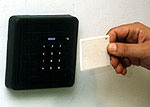
Several loops of control panels .
Door locking devices .
-Electromagnetic locks .
-Electric strikes .
Exit devices .
-Emergency exit bars
-Egress buttons
-Push buttons
Door closures with electric release ( Fire rated
doors ) .
Annunciation panels.
Many other components and interfaces.
 The
CCTV system is a closed circuit television. This
system is mainly used by security personnel to
monitor the traffic in a facility. The system is
able to switch any input video signal to any
output monitor, using the video switching
matrix.
The
CCTV system is a closed circuit television. This
system is mainly used by security personnel to
monitor the traffic in a facility. The system is
able to switch any input video signal to any
output monitor, using the video switching
matrix.
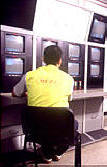 Also,
it is possible to switch any sequence of
pictures to any video output, with no limits on
simultaneous switching. The video output module
of the video-switching matrix amplifies the
video signals and interfaces with the control
unit CPU/MX from which it receives the switching
commands and to which it provides information
about its own status.
Also,
it is possible to switch any sequence of
pictures to any video output, with no limits on
simultaneous switching. The video output module
of the video-switching matrix amplifies the
video signals and interfaces with the control
unit CPU/MX from which it receives the switching
commands and to which it provides information
about its own status.
The CPU/MX coordinates the activities of all its
sub-system, so as to obtain from the system as a
whole the desired functioning.
The Intercom system in RHIAB project, Building
C1 , provide connection between a central room
and existing lifts.
The system is based on the following:
.A Digital Annunciator Panel displays incoming
calls from lifts and link faults.
.A flush mounted master station which, via its
keypad, allows the operator to call any
particular lift, other master station, and even
to pass into Conference and all call features.
.The main module of the system supervises all
the incoming and outgoing calls, it is installed
in Central Control room.
.A Digital Network Adapter offers the
possibility of interfacing the system to
computer utilities. It is installed in Central
Control room.
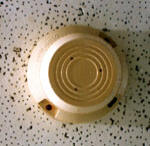 The
Fire Alarms Systems are present in all Rafik
Hariri International Airport - Beirut facilities complex. Two
different Fire Alarm Technology are being
implemented :
The
Fire Alarms Systems are present in all Rafik
Hariri International Airport - Beirut facilities complex. Two
different Fire Alarm Technology are being
implemented :
- Analogue Addressable System . It is
exclusively installed in C1 terminal building
and VIP pavilion.
- Analogue conventional system. This kind of
system is installed in all Annex Buildings, Run
Way Substations, and Under Passes sub stations.
Analogue Addressable system
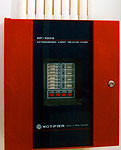 The
analogue Addressable system is based on state of
the art analogue software addressable
technology. This Fire Alarm is divided into
three main blocks located in the central room,
east satellite repeater room, and west satellite
repeater room, all networked via RS-485. The
Fire Alarm System monitors and controls more
than 2500 devices distributed through the
terminal building and it is interfaced to other
low currents systems and other Fire Alarm system
in some Annex buildings.
The
analogue Addressable system is based on state of
the art analogue software addressable
technology. This Fire Alarm is divided into
three main blocks located in the central room,
east satellite repeater room, and west satellite
repeater room, all networked via RS-485. The
Fire Alarm System monitors and controls more
than 2500 devices distributed through the
terminal building and it is interfaced to other
low currents systems and other Fire Alarm system
in some Annex buildings.
Analogue Conventional System
Most of the buildings are equipped with a fire
alarm system which consists of a multi zones
satellite fire alarm cabinet, alarm initiating
devices ( detectors and manual pull station) and alarm devices
(Horn, Bells).
The fire alarm control LSS4 itself consists of
conventional class B detection zones, 6 alarm
signaling circuits, power supply/charger and
standby sealed lead with batteries . It is a
self contained fire alarm control system
designed for medium size local system
applications. The other buildings have another
kind of Fire Alarm System of smaller capacities.
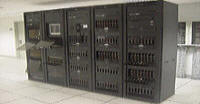 The
Announcement Control Systems integrate the
flexibility and the reliability of digital
technology into the professional audio field.
These systems are multi-function, professional
announce system, whose operations and digital
processing are controlled by microprocessors.
The
Announcement Control Systems integrate the
flexibility and the reliability of digital
technology into the professional audio field.
These systems are multi-function, professional
announce system, whose operations and digital
processing are controlled by microprocessors.
The existent Public Address System in RHIAB is a
computer controlled audio switching matrix. The
heart of the system is the Announcement Control
System. The ACS is configured for more than 50
microphone inputs and more than 100 speaker zone
outputs. Each speaker zone output from the ACS
is fed through one of the 3rd octave equalizer
which are located in the card frame rack. In
zones where there is a large influx of people,
there is Ambient Noise Sensor System, which job
to raise and/or lower the level of the public
address system in that zone automatically,
depending on the noise level in the area.
An important function of the ACS is the Digital
Recorded Playback and Permanent Digital Recorded
Playback systems.
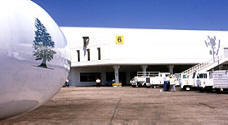 The RLG
AUTOMATED GUIDE-IN SYSTEM has been
developed to guide in and stop aircraft in a
precise position at airport terminals . The
system is designed to accommodate all aircraft
types on a single docking device, without error
factor involved with changes in height of
aircraft due to variation in gross weight.
The RLG
AUTOMATED GUIDE-IN SYSTEM has been
developed to guide in and stop aircraft in a
precise position at airport terminals . The
system is designed to accommodate all aircraft
types on a single docking device, without error
factor involved with changes in height of
aircraft due to variation in gross weight.
After proper arriving aircraft has been selected
and system test procedures have been followed,
the system is completely automatic. Lights on
the control panel and LCD screen will monitor
aircraft indicator and light housing .
 When aircraft arrives at the beginning of the
centerline, the laser scans and acquires the
nose of approaching aircraft and commences
tracking. The acquisition of the aircraft is
tracked until the final stop.
When aircraft arrives at the beginning of the
centerline, the laser scans and acquires the
nose of approaching aircraft and commences
tracking. The acquisition of the aircraft is
tracked until the final stop.
After acquisition, the docking system measures
the distance between the laser head and the nose
of the aircraft . Throughout the docking
process, the communication unit calculates the
closing rate information and displays it on the
display unit, enabling the pilot to properly
dock the aircraft.








 The
CCTV system is a closed circuit television. This
system is mainly used by security personnel to
monitor the traffic in a facility. The system is
able to switch any input video signal to any
output monitor, using the video switching
matrix.
The
CCTV system is a closed circuit television. This
system is mainly used by security personnel to
monitor the traffic in a facility. The system is
able to switch any input video signal to any
output monitor, using the video switching
matrix. Also,
it is possible to switch any sequence of
pictures to any video output, with no limits on
simultaneous switching. The video output module
of the video-switching matrix amplifies the
video signals and interfaces with the control
unit CPU/MX from which it receives the switching
commands and to which it provides information
about its own status.
Also,
it is possible to switch any sequence of
pictures to any video output, with no limits on
simultaneous switching. The video output module
of the video-switching matrix amplifies the
video signals and interfaces with the control
unit CPU/MX from which it receives the switching
commands and to which it provides information
about its own status. The
Fire Alarms Systems are present in all Rafik
Hariri International Airport - Beirut facilities complex. Two
different Fire Alarm Technology are being
implemented :
The
Fire Alarms Systems are present in all Rafik
Hariri International Airport - Beirut facilities complex. Two
different Fire Alarm Technology are being
implemented :  The
analogue Addressable system is based on state of
the art analogue software addressable
technology. This Fire Alarm is divided into
three main blocks located in the central room,
east satellite repeater room, and west satellite
repeater room, all networked via RS-485. The
Fire Alarm System monitors and controls more
than 2500 devices distributed through the
terminal building and it is interfaced to other
low currents systems and other Fire Alarm system
in some Annex buildings.
The
analogue Addressable system is based on state of
the art analogue software addressable
technology. This Fire Alarm is divided into
three main blocks located in the central room,
east satellite repeater room, and west satellite
repeater room, all networked via RS-485. The
Fire Alarm System monitors and controls more
than 2500 devices distributed through the
terminal building and it is interfaced to other
low currents systems and other Fire Alarm system
in some Annex buildings.  The
Announcement Control Systems integrate the
flexibility and the reliability of digital
technology into the professional audio field.
These systems are multi-function, professional
announce system, whose operations and digital
processing are controlled by microprocessors.
The
Announcement Control Systems integrate the
flexibility and the reliability of digital
technology into the professional audio field.
These systems are multi-function, professional
announce system, whose operations and digital
processing are controlled by microprocessors. The RLG
AUTOMATED GUIDE-IN SYSTEM has been
developed to guide in and stop aircraft in a
precise position at airport terminals . The
system is designed to accommodate all aircraft
types on a single docking device, without error
factor involved with changes in height of
aircraft due to variation in gross weight.
The RLG
AUTOMATED GUIDE-IN SYSTEM has been
developed to guide in and stop aircraft in a
precise position at airport terminals . The
system is designed to accommodate all aircraft
types on a single docking device, without error
factor involved with changes in height of
aircraft due to variation in gross weight.  When aircraft arrives at the beginning of the
centerline, the laser scans and acquires the
nose of approaching aircraft and commences
tracking. The acquisition of the aircraft is
tracked until the final stop.
When aircraft arrives at the beginning of the
centerline, the laser scans and acquires the
nose of approaching aircraft and commences
tracking. The acquisition of the aircraft is
tracked until the final stop.